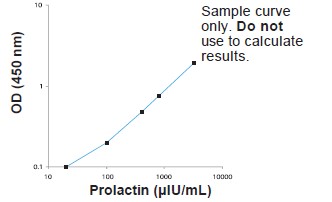Prolactin ELISA Assay Kit
The Prolactin ELISA Assay Kit is For Research Use Only
Size: 1×96 wells
Sensitivity: 10 μIU/mL
Dynamic Range: 20 – 3200 μIU/mL
Incubation Time: 1 hour 15 minutes
Sample Type: Serum
Sample Size: 25 µL
Assay Background
Prolactin (PRL) is a polypeptide hormone synthesized by the lactotropic cells of the anterior pituitary gland. Structurally, it is similar to two other polypeptide hormones namely, growth hormone, and placental lactogen. PRL is a polypeptide containing 199 amino acids, while growth hormone and placental lactogen each have 191 amino acids. There is approximately 100ug of prolactin in the human pituitary gland, which is a very small amount when compared to growth hormone, which is present at 8-10 mg. The target organ of prolactin is the breast (mammary gland). Its main physiological action is not only to initiate but also to sustain lactation. The hypothalamus secretes dopamine, which has a direct effect of inhibition of the secretion of PRL. If dopamine is not available or absent the secretion of PR: is autonomous. Clinical trends:
- In patients where tumors secrete prolactin there is a remarkable increase in the PRL level, which then decreases the secretion of gonadotropin resulting in infertility.
- If the pituitary gland is deficient it leads to failure of lactation.
- In Sheehan’s syndrome the pituitary gland is deficient, therefore the PRL level is reduced.
- A few conditions where increases in prolactin levels are found include: hyperprolactinemia, adnomas of the pituitary gland, sleep, pregnancy, hypothyroidism, prolactinomas and stress.
- Prolactinomas are pituitary tumors secreting prolactin, found most frequently in females. In females they lead to amenorrhoea, which could be primary or secondary and give rise to a decrease in gonadotropin secretion by the pituitary. In men some degree of impotency accompanied by a low testosterone level occurs, followed by azospermia.
Related Products
FSH ELISA Assay Kit
AFP ELISA Assay Kit
Beta-HCG ELISA Assay Kit



